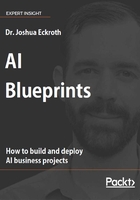
Chapter 1. The AI Workflow
Like so many technologies before and surely an infinite progression of technologies to come, a rtificial intelligence (AI) is the promising idea du jour. Due to recent advances in hardware and learning algorithms, new commercial-grade software platforms, and a proliferation of large datasets for training, any software developer can build an intelligent system that sees (for example, face recognition), listens (for example, writing emails by voice), and understands (for example, asking Amazon's Alexa or Google Home to set a reminder). With free off-the-shelf software, any company can have their own army of chatbots, automated sales agents customized to each potential customer, and a team of tireless web bots that scan the media for mentions and photos and videos of a company's products, among other use cases. All of these solutions may be built by regular software developers in regular companies, not just researchers in well-funded institutions.
But any seasoned professional knows that the risk associated with technology is proportional to its newness, complexity, and the number of exclamation points in its marketing copy. Tried-and-true techniques are low risk but might keep a company from taking advantage of new opportunities. AI, like any promise of intelligent automation, must be built and deployed with a specific business outcome in mind. One must have a detailed plan for integrating it into existing workflows and procedures, and should regularly monitor it to ensure the context in which the AI was deployed does not gradually or dramatically change, rendering the AI either useless, or worse, a rogue agent run amok..
This book combines practical AI techniques with advice and strategies for successful deployment. The projects are aimed at small organizations that want to explore new uses of AI in their organizations. Each project is developed to work in a realistic environment and solve a useful task. While virtually all other books, videos, courses, and blogs focus solely on AI techniques, this book helps the reader ensure that the AI makes sense and continues to work effectively.
In this first chapter, we're going to cover:
- The role of AI in software systems
- The details of a unique AI workflow that guides the development
- A brief overview of this book's coding projects